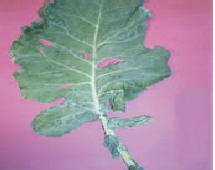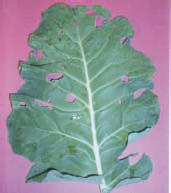|
Boron: “Deficiency
symptoms may be
more common than
you thought”
By: Ben Funnekotter
Grower
Solutions Magazine
Lefroy
Valley Magazine
August
2004
Brassica growers often think they have a
major problem with Diamond Back Moth
grub damage, and end up spraying
three or four times a week to try and
stop their produce looking as though a
hailstorm has ripped through the crop.

Boron Deficiencies - early stages
However, very often, this is not grub
damage at all but rather the classic
symptoms of Boron deficiency.
Boron deficiency is particularly
prevalent in the sandy soils of WA, but
that does not mean the other states in

Boron Deficiencies - later stages
|
Australia are exempt from such
problems. The two problems look very
similar at first glance, but by taking a
closer look, the differences become
apparent. A technical explanation of
what Boron does in the plant is not
necessary, suffice to say that it is taken
up in the cell wall, where one of it's
major functions is to strengthen the cell
wall.
When brassicas experience a Boron
deficiency, the leaves become thin and
are prone to tearing. Sometimes the
tearing occurs on the edge of the leaves,
and when the tear edge heals, the
brassica leaves (particularly cabbage leaves) become heart shaped rather than
round or oval. However, often a tear in the leaf of .5 - 1.5cm long takes place
in the centre of the leaf. As the torn edges heal the tear changes from a line
to a round or oval hole, which looks very similar to the "shot hole" symptoms of
grub damage.
Growers should look closely at their crops to detect the symptoms at an early
stage.
Often the symptoms of Boron deficiency occur despite high levels of
Boron being present in the irrigation water. Ideally the first
applications of Boron should be applied at seedling stage in the
nursery, as a foliar spray. Thereafter the next application should be
at transplant and again two weeks later.
There are many formulations of Boron on the market, some work better
than others, and their application rates vary, as do their application
costs. Without entering the minefield of products and costs, a rule of
thumb for the grower to use is that each treatment should cost about
$15 per hectare or less. Once applied, Boron will often have the
effect of making the crop dark green, without the flush of new growth
that Nitrogen applications would give. Yields should improve and
hollow stems should significantly decrease.
So the next time you think you have grub damage but the moth numbers
aren't around to warrant such large scale damage, remember to think of
Boron, it could save you a fortune in spraying costs.
|